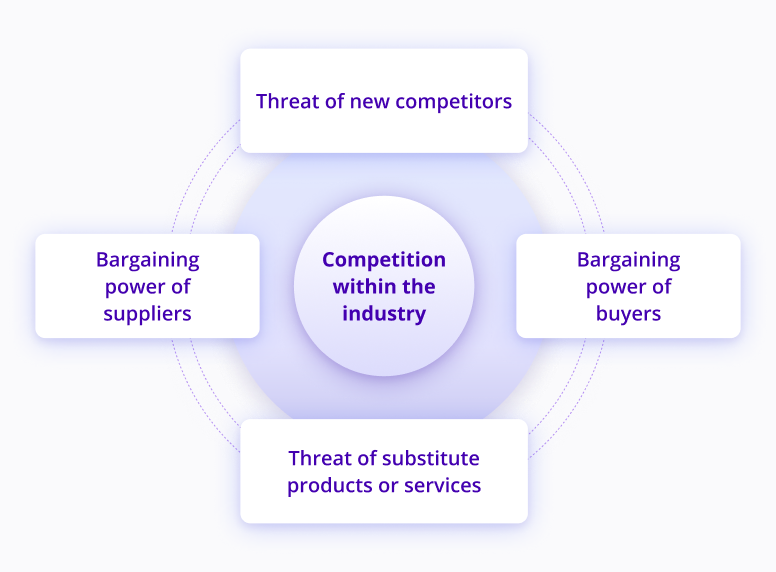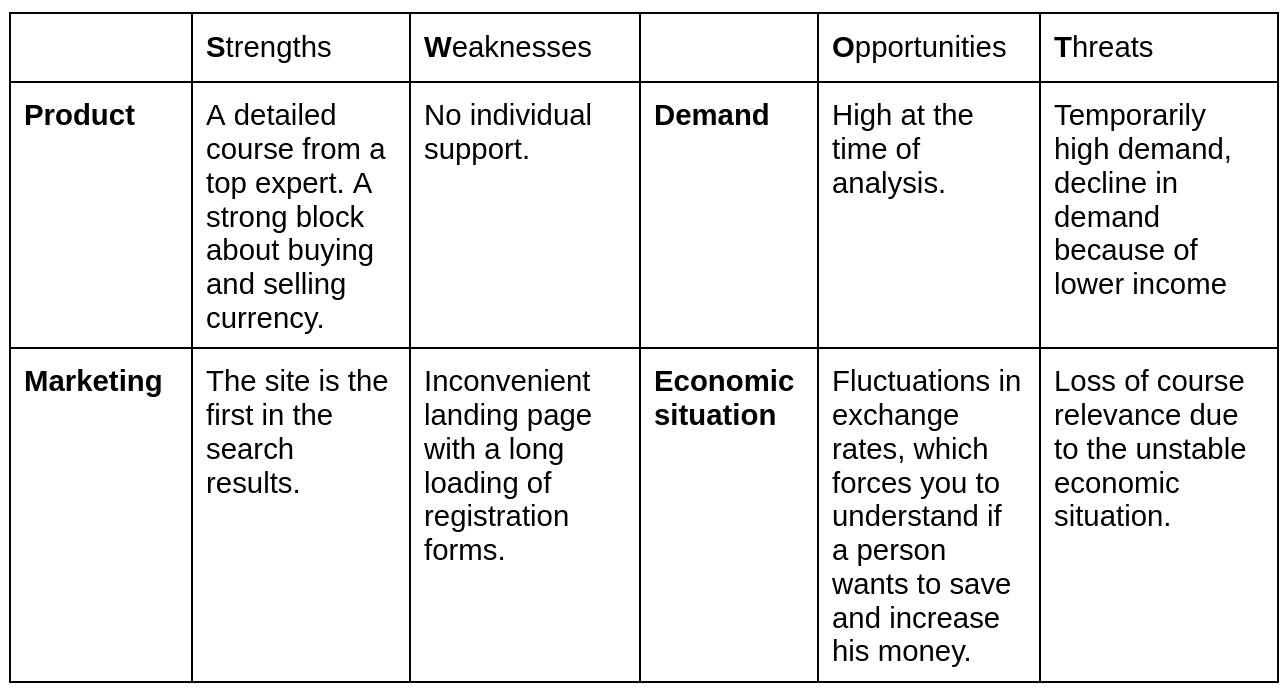Competitive Analysis: When, Why and How to Conduct

Entering the market blindly with a new product is a risk for a company. If you encounter a strong player there, the whole business plan will probably collapse and losses will follow. Even if your business has been operating for a long time, you shouldn’t underestimate existing competitors. The only way to stay competitive is to «run faster» than other companies with a similar product, or at least keep up with them. Perfect knowledge of your competitors plays a key role here. To achieve this, you need to conduct a competitive analysis.
Competitor research takes time and resources, but it pays off after all: the company reduces uncertainty, understands better how to grow the business, and makes fewer planning mistakes.
We will tell you what the analysis of competitors consists of: stages and methods, what benefits the knowledge of competitors brings to the business.
What is competitive analysis
Competitive analysis is the research of a company's competitors from the same field to bring products to the market and improve existing ones. The purpose of competitor analysis is to understand the disadvantages and advantages of competitors, their marketing features and development strategies, and then, based on this knowledge, correctly create your own business plan or edit an existing one.
Analysis and evaluation of competitors are regularly carried out to maintain market positions and improve products and services, as well as when launching new products.
What does competitive analysis do for your business:
- Forms adequate pricing.
- Shows the strengths and weaknesses of competitors and your company.
- Find gaps in your business.
- Gives a complete picture of the market where the business operates.
- Predicts negative consequences caused by wrong strategies.
- Shows business trends.
- Finds ideas and opportunities for company development.
How to look for competitors and what they are
Competitors include all organizations that create and sell the same or similar products. There are three types:
Direct competitors are companies that offer similar goods and services to a similar target audience.
Indirect competitors work with the same target audience, but offer different goods or services in the same category.
Replacement competitors exist outside your product category, but they satisfy a similar customer need.
How to find competitors
It depends on the capabilities of the company and the type of business: offline or online, B2C or B2B, etc.
Search options:
- analysis of advertising that a search engine shows if you enter a query containing your product or service;
- search queries on your topic in Google or Yandex;
- review sites;
- ratings of companies in the media;
- surveys of your customers;
- maps (for offline business);
- search for competitors on marketplaces.
How to do competitor analysis:
1. Set goals and choose the direction of competitive analysis. For example, a company can research only pricing policy to form its own correctly, or specific product lines. The goal emerges from the problem that the business is going to solve: find the best price, improve the product and promotion methods, etc.
2. Make a list of competitors for analysis. It is not necessary to analyze all existing competitors — it is enough to evaluate the main ones. The choice of the number of competitors depends on the resources of the company.
3. Identify sources for data collection: company website, public reports, ratings, social networks, reviews and other available channels.
4. Select competitor research methods: SWOT analysis, 7P, PEST and others (see below).
5. Collect data and create a map of competitors. Include them into a single table to simplify the work. The competitor analysis table includes:
- Company staff and management.
- Competitor's product features: size, type, packaging, and other characteristics.
- Product line: filling and volume.
- Estimated percentage of market share.
- Product quality and price ratio.
- Competitor pricing and discounts.
- Marketing metrics: site positions, SEO-promotion, strategy, advertising. Brand positioning and corporate identity.
- Channels for attracting and retaining customers: newsletters, gifts, events and others.
- Geography of the competitor: in which countries, regions and districts business operates.
- Unique features of competitors.
- Work of the company's staff.
- Organization of business processes.
- Strengths and weaknesses.
- Customer reviews and positions in industry ratings.
Important! Add to the competitor map only the data that is needed to achieve the goal of the analysis.
6. Carry out analysis using one or more methods.
7. Draw conclusions and act.
Competitive analysis methods
There is no single benchmark for competitive analysis. The company chooses the one that meets the needs. Consider the classical techniques that are used separately and in combination with others.
Comparison and evaluation
It is the easiest way. Take a map of competitors and compare your company with each of the list on a ten-point scale and according to the criterion «yes» or «no».
| Your business | Company A | Company B | Company C | |
|---|---|---|---|---|
| Product quality | 8 | 6 | 9 | 4 |
| Delivery speed | 5 | 8 | 3 | 10 |
| Customer reviews | 7 | 7 | 6 | 4 |
| Installment | yes | yes | no | yes |
7Рs
This is a classic marketing scheme consisting of seven parameters:
| Element | Description |
|---|---|
| Product | The product received by the end user, its brand identity, characteristics, uniqueness. |
| Price | Pricing policy of the company: retail and wholesale cost, the possibility of discounts. |
| Place | Online or offline platforms, distribution on shelves in offline stores and storage conditions. |
| Promotion | Advertising, social media marketing, events, company promotions. |
| People | Company staff who are responsible for sales to the end user. |
| Process | How the buyer and seller interact. |
| Physical evidence | What the customer sees when they buy a product or receive a service. |
Each element is described and assessed in a point system.
Analysis of digital resources of competitors
What elements are evaluated:
| Element | Description |
|---|---|
| Company website | Clearness and correctness of texts, site navigation convenience. Loading speed and correct operation of elements (for example, subscription forms). How much the site «sells» and SEO parameters. |
| Social media | How the brand leads social media: content, targeted advertising. How to communicate with users in the comments. |
| Advertising | What platforms and what calls to action does the competitor use, what keywords are promoted in contextual advertising. |
SWOT analysis
Comparison of strengths, weaknesses, opportunities and threats is also a classic marketing analysis that is suitable for studying competitors.
As usual, strengths and weaknesses are chosen as follows: company product, finance, staff organization, marketing, the state of production, the company's flexibility, which is responsible for the ability to adapt to change. For opportunities and threats, take into account scientific and technological progress, level of competition, demand for product, economic situation. Each item is described and evaluated on a ten-point scale.

PEST analysis
The method evaluates the business of competitors according to environmental factors that affect the company. The analysis finds market trends and can be combined with SWOT analysis.
What factors are included in the PEST analysis:
- Political. Legal environment of the company’s industry.
- Economical. Economic development, inflation, currency hikes, income and other.
- Socio-cultural. Education and age, cultural characteristics, tastes of the audience.
- Technological. Technology development, innovation, the role of the Internet in business development.
Porter's five forces
Porter's five forces model determines the strength of competitors, threats, finds competitive advantages and shows how to choose a niche and position a product correctly.
What elements does it consist of:

Threat of new competitors
If new companies come in with advanced technologies and innovative products, they are likely to «take» the company's customers in the existing market. The possibility of a competitor appearing through the entrance barrier to the industry is assessed.
Bargaining power of buyers
Analyze customer requirements for the product, satisfaction with goods and services. With high demands, the company will have to improve quality. Also, the company is affected by the volume of purchases: if the client makes large orders, he can dictate his terms. Especially when there are enough analogues on the market.
Bargaining power of suppliers
The business depends on the change in the price of products by the supplier. Analyze the volume of goods deliveries, alternatives and status of suppliers: monopoly or multivariate market.
Threat of substitute products or services
The client will change your product for an analogue if it turns out to be a good value for money. Therefore, it’s important to take into account the possibility of the appearance of such goods and create the uniqueness of your product in order to prevent substitution.
Competition within the industry
It shows how many players are on the market, the threshold for entering the industry, what conditions each offers, what alternatives there are for the client.
Competitive Analysis Example
An EdTech company is going to release a new online course.
- Purpose: to determine the optimal price of a new product on the market — a course on financial literacy.
- The list of competitors includes only players whose course cost is more than $300 and who conduct courses online and offline in St. Petersburg. These are companies A, B, C.
- Sources for finding information: company websites, trial webinars, feedback from participants.
- Choose SWOT analysis as a method.
- Make a map of competitors who have a similar course and include only the necessary data:
| Company A | Company B | Company C | |
|---|---|---|---|
| Course format | online | online | offline |
| Course duration | 3 weeks | 4 weeks | 2 weeks |
| Price for the same exchange rate in dollars | 300 | 350 | 330 |
| Minimum discount | 10% | 10% | 5% |
| Maximum discount | 40% | 25% | 30% |
| Availability of installments | yes | no | no |
| Price-quality ratio in points 1-10 | 6 | 3 | 8 |
- Conduct a SWOT analysis of each competitor. On the example of Company A:

- Draw your own conclusions. For example, during the analysis, it turned out that the course of our company is more informative than that of competitors. There is an option with individual support, which others don’t have. Then it’s reasonable to set the price higher than $700.
Resume
Competitive analysis is the process of studying competitors to scale a business, eliminate shortcomings in work, and bring new products to market. Business investigates direct, indirect and replacement competitors through available channels: company websites, social media, ratings, reviews, search results, maps and other ways.
For analysis, a map of competitors is compiled with the main characteristics of their businesses: product, marketing, staff work, prices. Also choose one of the research methods: comparison with evaluation, digital analysis of company resources, 7P model, SWOT or PEST analysis, Porter's five forces analysis. The company uses a convenient method that is suitable to achieve the purpose of the analysis.
You might be interested in:
Messaging apps are taking over the world and breaking records in app downloads. Read about how to use instant messaging platforms for business promotion.
Read moreThe best way to monitor your email marketing efforts is by analyzing your email marketing metrics. Here's a list of the most important metrics that you should care about.
Read moreFor those who have been waiting for updates in our platform for a long time.
Read more